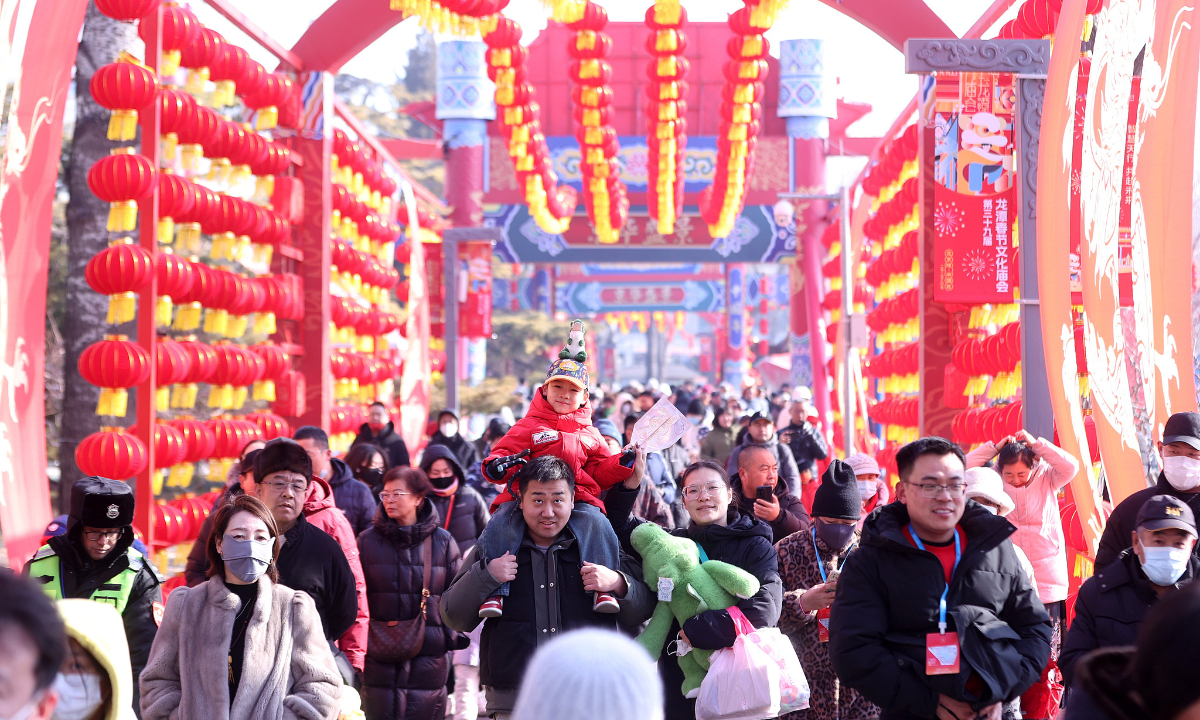
Photo:VCG
Editor's Note:For many Chinese, the heart of the Spring Festival lies in family reunion. This year, what makes the festival more special is that the Spring Festival has been inscribed as UNESCO Intangible Cultural Heritage of Humanity. This gives the Chinese festival a global connotation. The Global Times selects the opinions of some foreign experts to share their experiences and understanding of the Spring Festival.
Colin Mackerras, an Australian sinologist and Emeritus Professor at Griffith UniversityThe initial significance of the Spring Festival, or the Chinese New Year, was that it represented the reawakening of the natural world after the sleep of the winter. Crops were planted and livestock could breed. Family life held a very high priority.
Modern China has undergone a rapid urbanization process, and the latest census (2020) puts the proportion of people living in cities at 63.89 percent of the total. But the tradition of the importance of the family remains strong.
In practice what that means is that the Spring Festival is the time for family reunions. People go back to their hometown or village to see their grandparents or reunite with those they have not seen for a while due to the demands of work. I single out grandparents because in my observation young people are very respectful and loving toward the old, and vice versa. As a frequent teacher in China, I have often been told by colleagues and students about returning to see their elderly parents or grandparents during the Spring Festival. This is the season for banquets and enjoying good food and drink in a collective way.
Returning for family reunions has an important implication for the travel system. Family reunions involve the biggest temporary migration in the world. Fortunately, the high-speed trains make China railway system the best in the world, by far. But there are other ways of travel too. China's enormous population makes crowds very common. However, I have witnessed Chinese adapt to crowds very well in the sense that they remain calm in dealing with the discomfort and inconvenience that is often involved in this travel.
The significance of the Spring Festival is underlined internationally by the fact that, in December 2024, the UNESCO added the "Spring Festival, social practices of the Chinese people in celebration of the traditional New Year" to the Representative List of the Intangible Cultural Heritage of Humanity. It is clear that the family system remains very strong for Chinese not only in China but all over the world. And there is a significance that shows the nature of the Chinese to others as well. The family system defines Chinese culture and gives the Chinese a strong sense of identity. It also unites Chinese people in a way I personally find beautiful.
Erik Solheim, former under-secretary-general of the United Nations and former executive director of the UN Environment ProgrammeThis year, we are about to welcome a truly "intangible heritage Spring Festival," as it marks the first celebrated under the prestigious recognition of being inscribed on UNESCO's Intangible Cultural Heritage list. As a long-time friend of China, I have had the privilege of witnessing the splendor of the Spring Festival many times. Yet, what never ceases to amaze me is its extraordinary vitality - a cultural tradition that is deeply woven into the lives of countless generations.
Today this spirit is vividly demonstrated by Chunyun - the world's largest annual migration, creating the largest human movement on the planet. At the close of the year, millions return to their hometowns and families, finding emotional nourishment in the warmth of reunions, the dazzling fireworks and heartfelt New Year greetings.
As we look ahead to 2025, the uncertainties of the future weigh heavily. Will the challenges deepen divides, or could they inspire a renewed commitment to collaboration and shared progress? The answers, as always, rest in how we choose to respond.
Ken Hammond, a professor of East Asian and global history at New Mexico State UniversityAs we approach the Chinese New Year, I remember my first experience of the holidays, in 1983 in Beijing. I was living on the west side, near the Diaoyutai, working for an American organization that sent students to study in China, one of the earliest such programs, at a time when relations between our countries were expanding and China was embarking on the era of reform and opening-up. Despite the bitter cold of the winter weather, the campus where I was staying was filled with the warmth of new encounters between our students and our hosts. As the New Year approached, everyone eagerly anticipated the coming of the Year of the Pig.
We Americans learned about the traditions of renewal and the rituals of family and community that bound people together at this important time of the year. On the night of the New Year there were celebrations on campus, and fireworks were set off to welcome the new day.
Over the 42 years since that first Spring Festival, I have celebrated the holiday with friends and family both in China and here in America. The Chinese New Year is a truly global event, as both overseas Chinese communities and the many friends and admirers of China in
countries around the world join in marking the turning of the annual cycle and the spirit of solidarity and of shared hopes for the future of all humanity.
Now another year is about to turn. Much has changed in China since 1983. The lives of the people have been dramatically improved, and the country is steadily advancing along the path of development and socialist construction. Let us all welcome the Year of the Snake, and join together in working for a better tomorrow.




